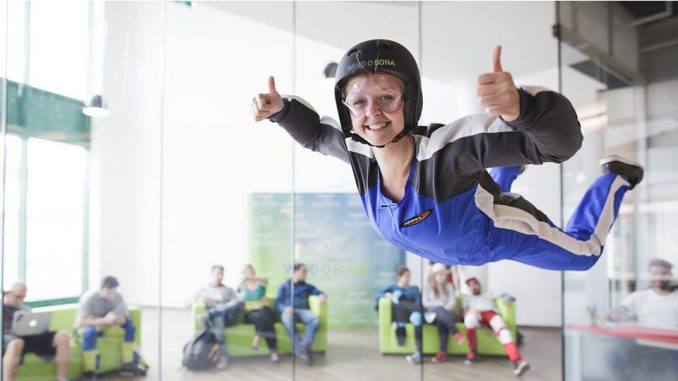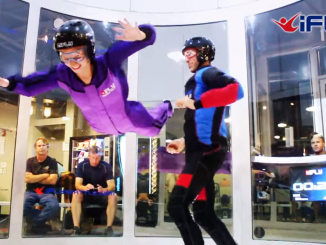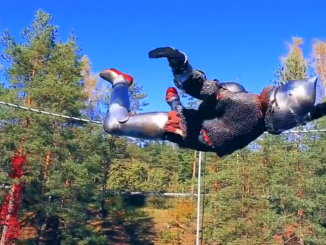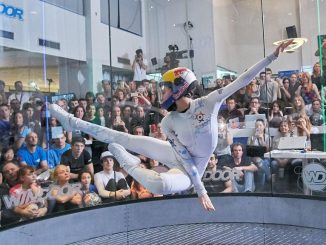
Ever fancied trying skydiving, but can’t pluck up the courage? Well indoor skydiving could be the perfect activity to get you closer to your dream. It’s a safer alternative for those not quite ready to make the leap (literally). Not only will you get to experience the thrill of skydiving in a safe environment, you’ll also be able to refine your basic free-fall technique before you sign up for a full-on skydiving experience. Here’s everything you need to know about indoor skydiving to get your skydiving dream kickstarted.
What is indoor skydiving?
Quite simply, indoor skydiving is a simulation of skydiving in an indoor wind tunnel. It’s the closest thing you’ll ever get to the real thing and it enables you to taste the excitement of free falling in a completely safe environment. Wearing appropriate clothing, you step into wind that is powerful enough to lift you 20 feet up in the air. All you need to do is straighten your arms and let yourself go.
Most indoor skydiving venues give you two 1-minute flights, which amounts to the equivalent freefall distance of 2 miles! While you bob around on the bed of air, there will be an instructor close by coaching you in technique.
Once you’ve mastered some of the techniques you’ll be able to manoeuvre yourself around and fully immerse yourself in the experience. It’s safe and it’s incredibly close to the real thing, so if you’re a skydiving toe dipper, this is definitely the activity for you. Most places also offer video footage for an extra fee so you can keep the memory of your experience alive.

What to expect
Most indoor skydiving places have a viewing deck, so you will be able to watch other participants flying before you take a turn. You’ll also receive some classroom flight training before you get into the wind tunnel. You’ll be shown the hand signals your instructor will use and get briefed on safety and what to do to get the most out of the experience.
You will then get geared up in a flight suit, helmet and goggles. When you enter the flight chamber, your instructor will guide you on how to lean in so you can fly like a superhero. It’s easy and takes the fear factor of jumping out of a plane out of the equation. It’s the perfect way for wannabe skydivers to dip their toes without jumping from a great height.
Who can practice indoor skydiving
Anyone from age 3 to 103 can experience indoor skydiving, adults and children alike. There are very few reasons you may not be able to fly, and many people with disabilities are able to participate.
You CANNOT fly if you:
- weigh over 18 stone (114kg)
- are under 3 years old
- are pregnant
- have previously dislocated your shoulder
- are under the influence of alcohol or drugs
- are wearing a hard cast
You will need signed permission to fly if you are under 18, and you will need to sign a declaration of risk before flying.

More about the wind tunnel
Wind tunnels have been used since the end of the 19th century in the automotive, aircraft and spacecraft industries to research the aerodynamics of objects, such as cars, aircraft, trains, buildings and bridges. Scale models are often used, but some wind tunnels are made to test full-size vehicles. For vehicle testing, MIRA has the UK’s only full scale aerodynamic wind tunnel.
The wind tunnel concept was adapted to create vertical wind tunnels because horizontal wind tunnels were found to be inadequate in certain testing situations, such as testing for helicopter blades and parachutes. The first ever vertical wind tunnel on record is the vertical spin tunnel at the NASA Langley Research Centre in Virginia, U.S.A. This model was too slow (an approximate 58 mph top speed) for human flight.
The wind tunnel at the Wright-Patterson Air Force Base in Ohio, U.S.A. is famous in the world of indoor skydiving. The late Jack Tiffany was the first recorded human to ever fly in a wind tunnel there. He took the flying plunge in 1964. At the time, the wind tunnel was used for testing parachute clusters as part of the Apollo space program.

The first wind tunnel designed and built specifically for humans to skydive in was in Canada in 1978. The machine was designed by Jean St-Germain who wanted to create an environment where his kids could experience freefall safely. He later sold the design to Les Thompson and Marvin Kratter. Thompson built Flyaway in Pigeon Forge, while Kratter created Vegas Indoor Skydiving. St-Germain’s innovative invention was dismantled in 1998.
In 1997 SkyVenture filed a patent for a modern wall-to-wall vertical wind tunnel design. It was the first model to include an enclosed flight chamber with airflow present from wall to wall, which offered increased safety as users can’t fly out of the column of air.
Since then, there have been various innovations to improve the design and the diameter. The world’s widest flight chamber to date is currently under construction in Abu Dhabi (United Arab Emirates) with an unmatched width of 32 feet. Completion is due in 2018.
Where to make your first flight
To experience Indoor Skydiving in the UK you can visit Into The Blue where you will find many more indoor and outdoor activities.
There are more than 200 wind tunnel in the world to try your first flight, just find the closest wind tunnel and start your adventure now!
Words by Mike James



